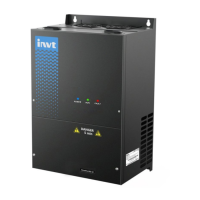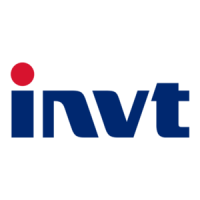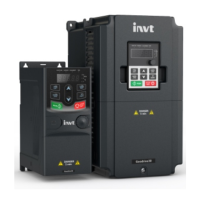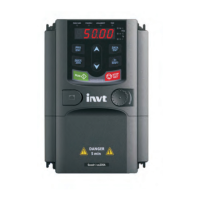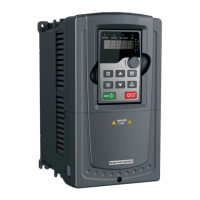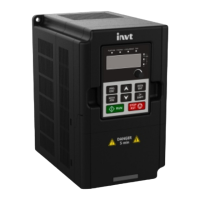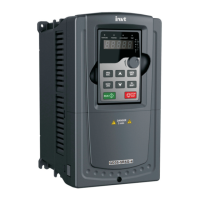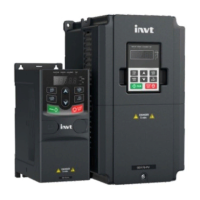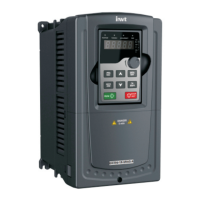
Do you have a question about the INVT Goodrive300-19 Series and is the answer not in the manual?
Defines danger, warning, and note levels for safety precautions.
Explains symbols used in the manual to denote hazards.
Provides essential rules for operating the inverter safely.
Defines danger, warning, and note levels for safety precautions.
Explains symbols used in the manual to denote hazards.
Provides essential rules for operating the inverter safely.
Checks for damage, correct type, and complete accessories after receiving the product.
Verifies load type, motor current, grid voltage, and communication needs before use.
Checks ambient temperature, humidity, altitude, and site conditions for proper installation.
Outlines essential steps for initial inverter setup and motor parameter configuration.
Lists detailed technical specifications including input/output, control features, and interfaces.
Provides a table of detailed power ratings, input currents, and output currents for various models.
Illustrates the physical layout and components of the inverter.
Covers environmental conditions, installation direction, manner, and spacing requirements.
Provides detailed diagrams and instructions for connecting main and control circuits.
Details protective measures against short circuits and thermal overload for the inverter and motor.
Introduces the inverter's keypad, standard LED, optional LCD, and fixing methods.
Describes the different display states: stopping, running, parameter editing, and fault alarm.
Guides on modifying function codes, setting passwords, and watching inverter states.
Introduces the structure of function parameters and their organization into groups (P00-P29).
Provides a step-by-step guide for initial power-up and inverter initialization.
Explains the principles and application of vector control for asynchronous motors.
Covers torque and rotation speed control modes, focusing on stable torque and output frequency management.
Guides on setting motor parameters and performing autotuning for optimal performance.
Details the three starting methods and logic for managing motor start-up and stop.
Explains various methods for setting frequency, including main and assistant reference channels.
Describes the analog input terminals (AI1, AI2, AI3) and their configuration for voltage or current input.
Details the functions of programmable digital input terminals and their configuration via function codes.
Provides guidance on identifying, diagnosing, and resolving common inverter faults and alarms.
Introduces different operating modes tailored for hoist applications, including common, joystick, and remote control.
Covers the sequence of brake switching for safe and reliable hoist control, including switching-on and off logic.
Explains how faults are indicated via LEDs and keypad messages, and how to identify causes.
Describes methods to reset faults, including using the STOP/RST key or switching power.
Provides a table listing fault codes, causes, and recommended solutions for troubleshooting.
Offers diagnostic flowcharts for common issues like motor not working, vibration, overvoltage, and undervoltage.
Lists recommended routine maintenance checks for ambient environment, voltage, keypad, and main circuit.
Discusses the cooling fan's lifespan, replacement procedure, and maintenance diagrams.
Explains capacitor reforming procedures based on storage time and capacitor replacement guidelines.
Covers safety precautions and checks for power cable connections.
Explains Modbus protocol basics, transmission modes (ASCII, RTU), and network structure.
States that the inverter uses RTU mode over RS485 for communication.
Illustrates the structure of RTU frames, including START, ADDR, CMD, DATA, and CRC fields.
Covers command codes (03H, 06H, 08H) for reading, writing, and diagnosis, with examples.
Lists common communication issues like no response or abnormal faults and their possible causes.
Covers inverter sizing based on motor current/power and derating factors for temperature, altitude, and frequency.
Details how ambient temperature, altitude, and carrier frequency affect inverter output capacity.
Lists grid voltage, short-circuit capacity, and frequency specifications.
Provides data for asynchronous induction motors, including voltage, protection, and frequency.
Specifies maximum motor cable lengths for compliance with EMC Directive at 4kHz switching frequency.
Shows the structure diagram and installation dimensions for the inverter keypad.
Presents detailed installation dimensions for wall, flange, and floor mounting across different power ranges.
Illustrates the peripheral wiring connections for Goodrive300-19 series inverters.
Describes various cable types (power, control, relay, keypad) and their functions.
Discusses the role of input, DC, and output reactors in improving power factor and preventing damage.
Explains the function of input and output filters for reducing interference and radio noise.
Covers selecting and installing braking resistors or units to manage regenerative energy and prevent inverter damage.
Directs users to local INVT offices for product inquiries and support contacts.
Encourages user feedback on manuals via the INVT website.
Guides users on how to find manuals and documents in PDF format on the INVT website.
